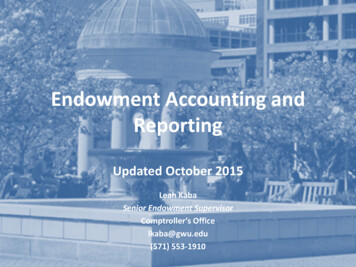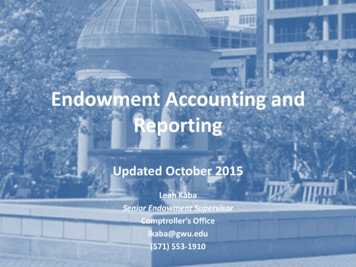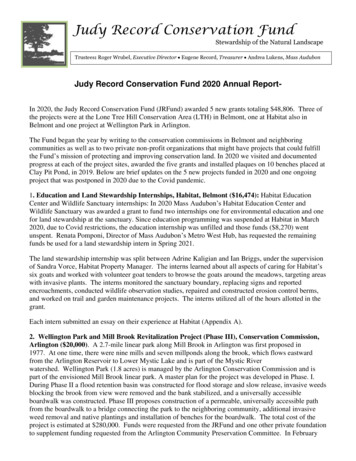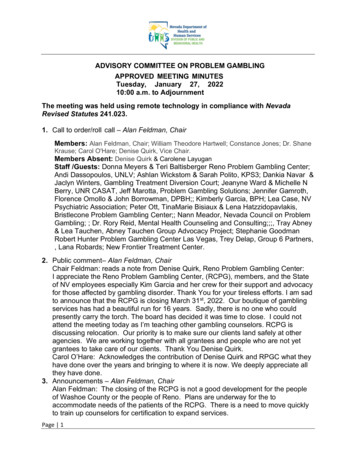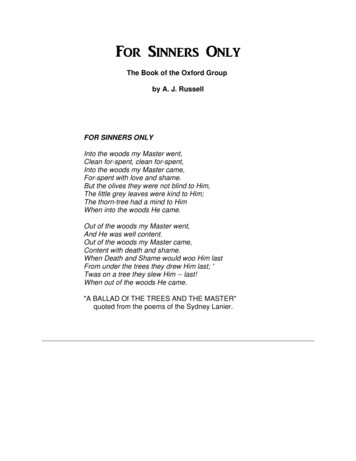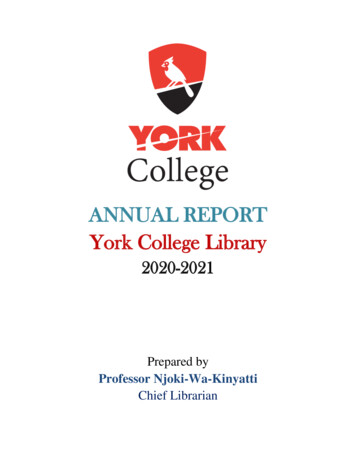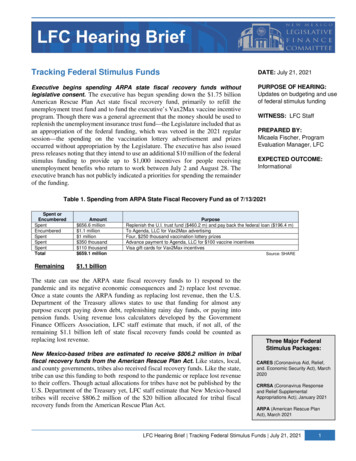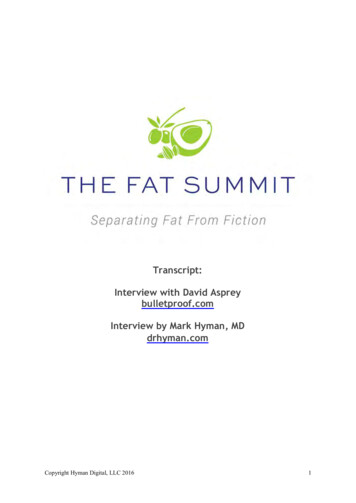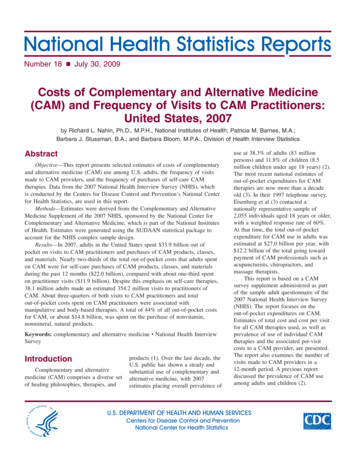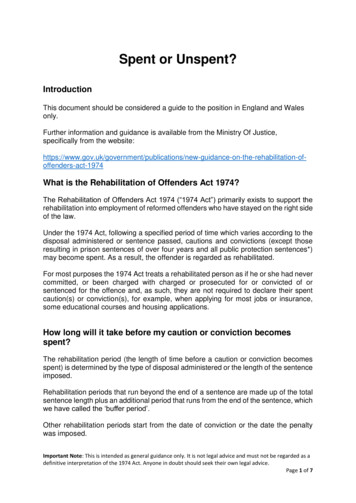
Transcription
Spent or Unspent?IntroductionThis document should be considered a guide to the position in England and Walesonly.Further information and guidance is available from the Ministry Of Justice,specifically from the t-1974What is the Rehabilitation of Offenders Act 1974?The Rehabilitation of Offenders Act 1974 (“1974 Act”) primarily exists to support therehabilitation into employment of reformed offenders who have stayed on the right sideof the law.Under the 1974 Act, following a specified period of time which varies according to thedisposal administered or sentence passed, cautions and convictions (except thoseresulting in prison sentences of over four years and all public protection sentences*)may become spent. As a result, the offender is regarded as rehabilitated.For most purposes the 1974 Act treats a rehabilitated person as if he or she had nevercommitted, or been charged with charged or prosecuted for or convicted of orsentenced for the offence and, as such, they are not required to declare their spentcaution(s) or conviction(s), for example, when applying for most jobs or insurance,some educational courses and housing applications.How long will it take before my caution or conviction becomesspent?The rehabilitation period (the length of time before a caution or conviction becomesspent) is determined by the type of disposal administered or the length of the sentenceimposed.Rehabilitation periods that run beyond the end of a sentence are made up of the totalsentence length plus an additional period that runs from the end of the sentence, whichwe have called the ‘buffer period’.Other rehabilitation periods start from the date of conviction or the date the penaltywas imposed.Important Note: This is intended as general guidance only. It is not legal advice and must not be regarded as adefinitive interpretation of the 1974 Act. Anyone in doubt should seek their own legal advice.Page 1 of 7
The ‘buffer periods’ are halved for those who are under 18 at the date of conviction(save for custodial sentences of six months or less where the ‘buffer period’ is 18months).The rehabilitation periods for sentences with additional “bufferperiods” which run from the end date of the sentence are shown inthe table below:Sentence/disposalBuffer period foradults(18 and over at thetime of conviction orthe time the disposalis administered).This applies from theend date of thesentence (includingthe licence period).Custodial sentence* of over 4 Never spentyears, or a public protectionsentenceCustodial sentence of over 30 7 yearsmonths (2 ½ years) and up toand including 48 months (4years)Custodial sentence of over 6 4 yearsmonths and up to andincluding 30 months (2 ½years)Custodial sentence of 6 2 yearsmonths or lessCommunity order or youth 1 yearrehabilitation order**Buffer period foryoung people (under18 at the time ofconviction or the timethe disposal isadministered).This applies from theend date of thesentence (includingthe licence period).Never spent3½ years2 years18 months6 months*Custodial sentence includes a sentence of imprisonment (both an immediatecustodial sentence and a suspended sentence), a sentence of detention in a youngoffender institution, a sentence of detention under section 91 of the Powers of CriminalCourts (Sentencing) Act 2000, a detention and training order, a sentence of youthcustody, a sentence of corrective training and a sentence of Borstal training.**In relation to any community or youth rehabilitation order which has no specified enddate, the rehabilitation period is 2 years from the date of conviction.Important Note: This is intended as general guidance only. It is not legal advice and must not be regarded as adefinitive interpretation of the 1974 Act. Anyone in doubt should seek their own legal advice.Page 2 of 7
The following table sets out the rehabilitation period for sentenceswhich do not have “buffer periods” and for which the rehabilitationperiod runs from the date of conviction:Sentence/disposalRehabilitation periodfor adults(18 and over at thetime of conviction orthe time the disposalis administered).Fine1 yearConditional discharge,Period of the orderAbsolute dischargeNoneConditional caution and youth 3 months or when theconditional cautioncaution ceases to haveeffect if earlierSimple caution, youthSpent immediatelycautionCompensation order*On the discharge of theorder(i.e. when it is paid in full)Binding over orderPeriod of the orderAttendance centre orderPeriod of the orderHospital order (with or without Period of the ordera restriction order)Referral orderNot available for adultsReparation orderNot available for adultsRehabilitation periodfor young people(under 18 at the timeof conviction or thetime the disposal isadministered).6 monthsPeriod of the orderNone3 monthsSpent immediatelyOn the discharge of theorder (i.e. when it is paidin full)Period of the orderPeriod of the orderPeriod of the orderPeriod of the orderNoneExamples:A 2-year custodial sentence given to an adult may become spent after 6 years: therehabilitation period is the period of the sentence plus a further ‘buffer period’ of 4years, giving a total of 6 years.A 2-year custodial sentence suspended for 2 years is spent after 6 years; therehabilitation period is the period of the custodial sentence plus a further buffer periodof 4 years giving a total of 6 years. (A suspended sentence is a sentence ofimprisonment and the rehabilitation period is therefore determined by the custodialsentence, regardless of the period for which it is suspended).A 6-month sentence of detention given to a young person may become spent after 2years: the rehabilitation period is the period of the sentence plus a further ‘bufferperiod’ of 18 months, giving a total of 2 years.Important Note: This is intended as general guidance only. It is not legal advice and must not be regarded as adefinitive interpretation of the 1974 Act. Anyone in doubt should seek their own legal advice.Page 3 of 7
A 1-year community order given to an adult may become spent after 2 years: therehabilitation period is the length of the order plus a further ‘buffer period’ of 1 year,giving a total of 2 years.A 1-year youth rehabilitation order given to a young person may become spent after18 months: the rehabilitation period is the length of the order plus a further ‘bufferperiod’ of 6 months, giving a total of 18 months.An adult who is given a fine will have to declare this conviction for 1 year from the dateof conviction before it is considered spent.*Compensation Orders – it is important that individuals obtain proof of payment fromthe court and keep this document to prove that the compensation order has been paidin full.Are there any sentences which are not covered by the 1974 Act?The following sentences are exempt from the 1974 Act and can neverbecome spent:a. Sentence of imprisonment for life;b. Sentence of imprisonment, youth custody, detention in a young offenderinstitution or corrective training of over 4 years;c. Sentence of preventive detention;d. Sentence of detention during Her Majesty’s pleasure or for life;e. Sentence of custody for life;f. Public protection sentences (imprisonment for public protection, detention forpublic protection, extended sentences of imprisonment or detention for publicprotection and extended determinate sentences for dangerous offenders).What are the rehabilitation periods for motoring offences?An endorsement for a road traffic offence listed in Schedule 2 to the Road TrafficOffenders Act 1988, imposed either by the court or by means of a fixed penaltynotice (FPN) is a sentence for the purposes of the 1974 Act and may become spentafter 5 years (or two and half years where the offender is under 18). Road trafficlegislation specifically provides for a FPN in these circumstances to be treated as aconviction and dealt with as such under the 1974 Act. Penalty points and a drivingdisqualification imposed by the court on conviction may become spent when theycease to have effect (penalty points have effect for three years as set out in roadtraffic legislation). Where the court imposes more than one sentence or penalty forthe offence then the longest rehabilitation period determines when the convictionmay become spent.Important Note: This is intended as general guidance only. It is not legal advice and must not be regarded as adefinitive interpretation of the 1974 Act. Anyone in doubt should seek their own legal advice.Page 4 of 7
A fixed penalty notice (FPN) can be used to deal with minor road traffic offences, butit is not a criminal conviction or a caution and the 1974 Act does not apply.ExamplesAn adult is convicted of a road traffic offence, and the court imposes a fine(rehabilitation period 1 year), an endorsement (rehabilitation period 5 years), penaltypoints (rehabilitation period 3 years) and driving disqualification for 1 year(rehabilitation period 1 year); the rehabilitation period for this conviction will be 5 yearsbecause the endorsement carries the longest rehabilitation period.If the offender was under 18 and received the above sentence, the conviction maybecome spent after 3 years because the longest rehabilitation period applicable wouldthen be three years for the penalty points (the endorsement would become spent aftertwo and half years).Once the conviction becomes spent, the person is not required to declare it whenapplying for most jobs, or (motor) insuranceIt is the case for all convictions (not only road traffic convictions) that where more thanone sentence or penalty is imposed then the conviction may only become spent oncethe longest rehabilitation period which applies has ended.For more information on the rehabilitation periods for particular driving offences,please t happens if I get another caution or conviction before my firstconviction becomes spent?If you already have an unspent conviction and you get a further caution or convictionbefore the earlier conviction has become spent, one of the following will apply:a. If your later outcome is a caution (either a simple caution or a conditionalcaution), neither rehabilitation period will be affected. The conviction for theearlier offence will become spent at the time originally fixed, and the cautionfor the later offence will become spent after the normal period (immediately fora simple caution or three months for a conditional caution).b. If your later outcome is a conviction, then neither conviction will become spentuntil the rehabilitation periods for both offences are over. This applies tosummary offences (offences that can only be tried in a magistrates’ court) aswell as either way offences (triable in either the magistrates’ court or theCrown Court) and indictable only offences (offences that can only be tried inthe Crown Court). Please note that there are very limited exceptions to thisunder section 6(5) of the 1974 Act.Important Note: This is intended as general guidance only. It is not legal advice and must not be regarded as adefinitive interpretation of the 1974 Act. Anyone in doubt should seek their own legal advice.Page 5 of 7
c. If your later outcome is a conviction that results in a custodial sentence ofmore than four years or a public protection sentence of any length, thenneither the second nor the first conviction will ever become spent.Once a conviction becomes spent, it remains spent, even if a person is convicted ofother offences later.What happens if I get another conditional caution or convictionbefore my first conditional caution becomes spent?If the later conditional caution or conviction is separate to the earlier conditional caution(i.e. not for the offence in respect of which you were cautioned), then neitherrehabilitation period will be affected. The conditional caution for the earlier offence willbecome spent at the end of 3 months from when it is given, and the caution orconviction for the later offence will become spent after the normal period. ImportantNote: This is intended as general guidance only. It is not legal advice and must not beregarded as a definitive interpretation of the 1974 Act. Anyone in doubt should seektheir own legal advice.For example: A person receives a conditional caution for shoplifting. A month later hereceives a conviction for a separate offence. The conditional caution will become spentin the normal way (three months from the date of issue) and, in relation to theconviction for the separate offence the rehabilitation period will apply for the sentenceimposed by the court.However, if you fail to comply with a conditional caution, and you are subsequentlyprosecuted the conditional caution will cease to have effect. Any subsequentconviction will then attract the relevant rehabilitation period for the sentence imposedby the court.For example: A person receives a conditional caution for shoplifting. He fails tocomply with the conditions and as a result is prosecuted for, and convicted of, theshoplifting offence for which he receives a fine, The conditional caution ceased tohave effect when he was prosecuted and he now has a conviction with a 12 monthrehabilitation period because, in this example, he was sentenced to a fine.I have been sentenced for more than one offence at the same time.Will the rehabilitation periods run concurrently or consecutively?If you receive more than one sentence at the same time, the total rehabilitation periodwill depend on whether the sentences run concurrently (at the same time) orconsecutively (one after the other).If concurrent sentences are imposed, then the longest applicable rehabilitation periodwill apply to all the sentences.Important Note: This is intended as general guidance only. It is not legal advice and must not be regarded as adefinitive interpretation of the 1974 Act. Anyone in doubt should seek their own legal advice.Page 6 of 7
For example, a four-month and six-month prison sentence ordered to run concurrentlywill count as a single term of six months (carrying a “buffer period” of two years fromthe end of the sentence, giving a total rehabilitation period of two years and 6 monthsbefore both convictions can be considered spent).If consecutive sentences are imposed, then the sentences will be added together tocalculate the rehabilitation period.For example, a four-month and six-month prison sentence running consecutively willcount as a ten-month sentence (carrying a “buffer period” of four years from the endof the sentence, giving a total rehabilitation period of four years and ten months beforethe convictions can be considered spent).Important Note: This is intended as general guidance only. It is not legal advice and must not be regarded as adefinitive interpretation of the 1974 Act. Anyone in doubt should seek their own legal advice.Page 7 of 7
a. Sentence of imprisonment for life; b. Sentence of imprisonment, youth custody, detention in a young offender institution or corrective training of over 4 years; c. Sentence of preventive detention; d. Sentence of detention during Her Majesty's pleasure or for life; e. Sentence of custody for life; f.
